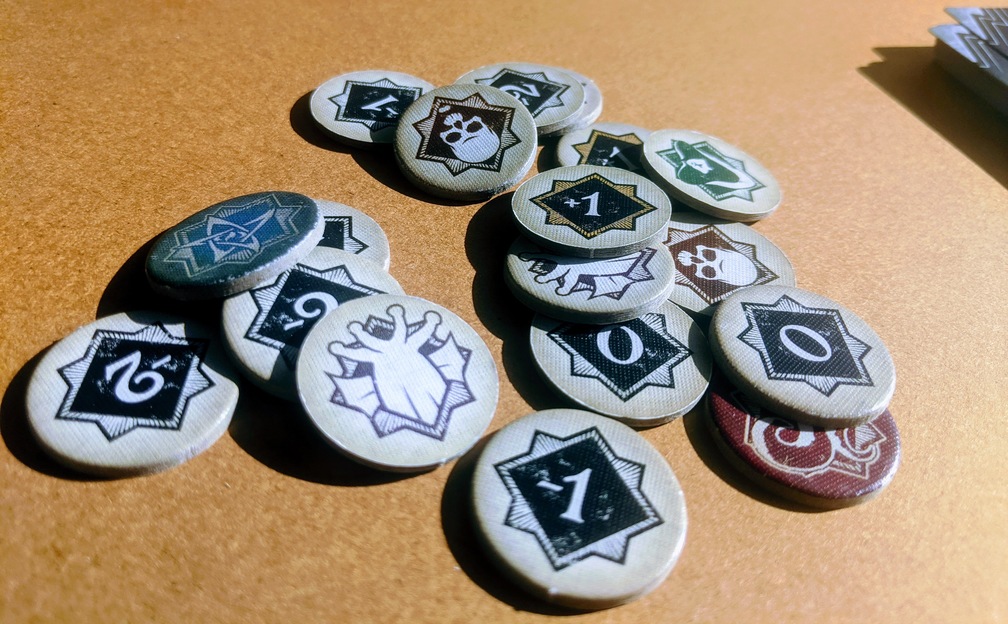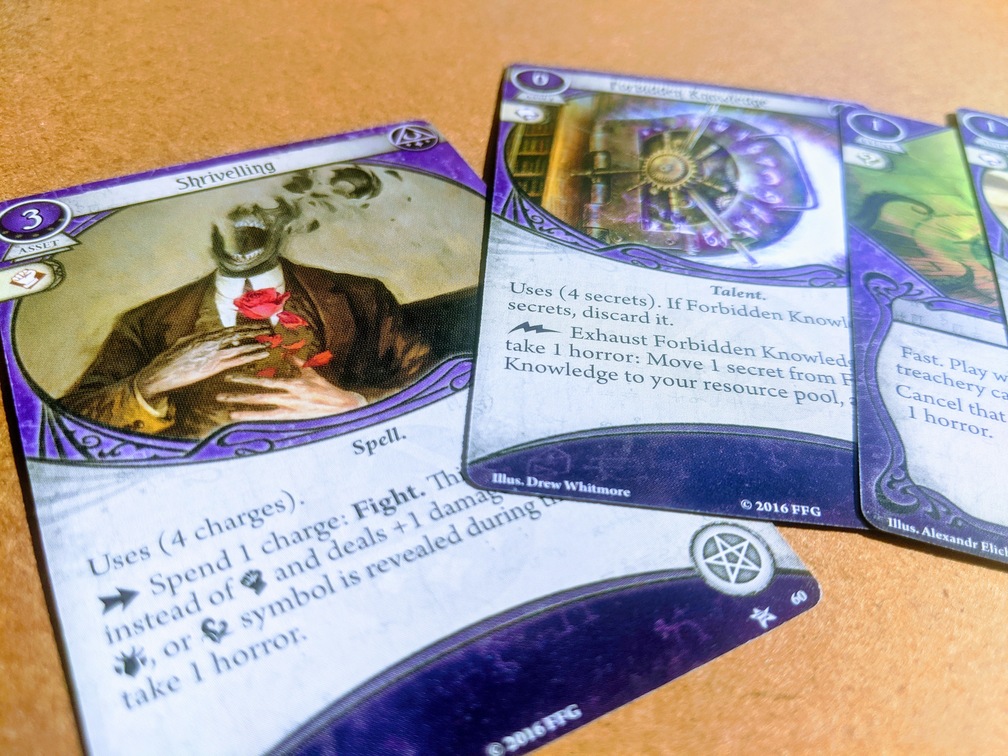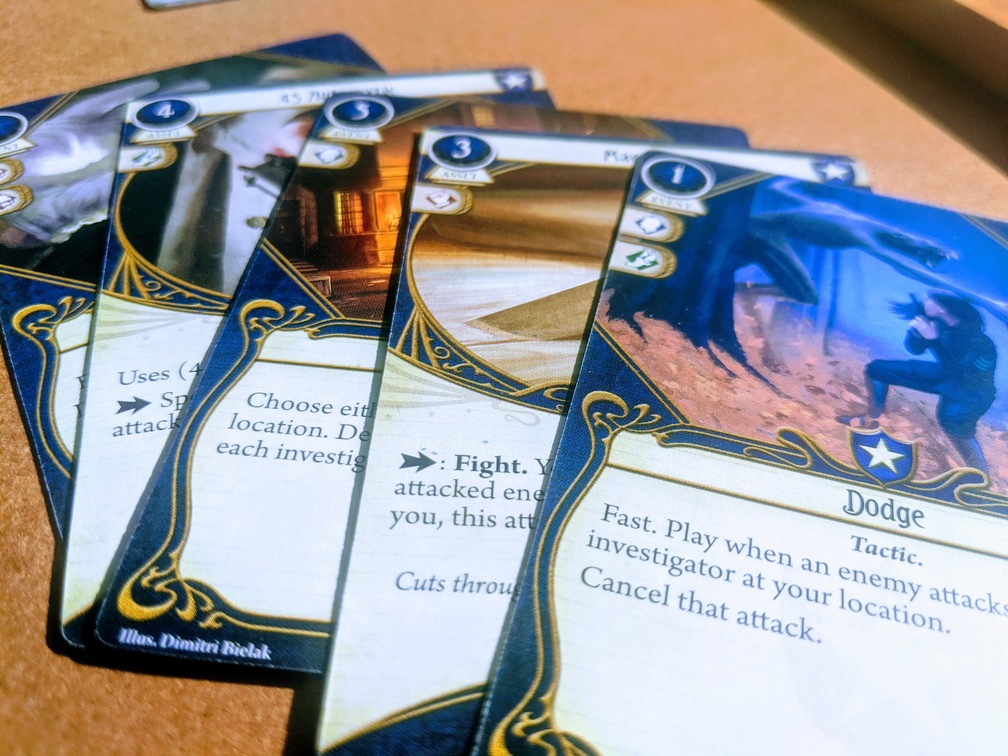“Okay, so I am going to pick up these 2 clues, you do another one in the Library, and then we can finish the game.”
“Let’s hope the encounters are merciful.”
“Oh please, even if I draw a monster, I have a card that will stop it from spawning at my location. And I can take plenty more damage and horror.”
“Okay, here it goes. My encounter is adding one doom to the agenda, not too bad.”
“Oh.””
What?”
“So apparently I have locked myself out of my location. I can’t get clues unless I break down the door or pick the lock. And both tests have a difficulty of 4.”
“Oh. So I guess we are not finishing the game?”
“Not anytime soon.”
Oh, Lovecraftian FFG games, why can’t I stop playing you. This review is going to be somewhat biased because I just like these games so much, despite their glaring issues.
First of all, this is a card game, more precisely a living card game. You still have to buy packs just like you do with collectable card games like Magic, but the decks are not randomized, you are buying specific core sets or expansions. This is already nice, you know what you get with each deck, and top it all off, this is a story-driven living card game.
To start things off you need to buy the core set, which comes with five investigators and three scenarios.

Each scenario comes with a set of acts and agendas, locations, and encounters.
The story is driven by the acts and agendas. Your goal is to fulfil the objective of all the acts, usually by gathering a prerequisite number of clues. The agenda, on the other hand, progresses once a specific number of doom tokens are placed on it. You have to add a doom token during each round, and there are some cards that might also bring forth the doom. The game state usually changes as you progress through the different acts and agendas, you might have to make decisions along the way, monsters might spawn, or magic items might be found.
The locations provide the exploration part aspect of the game. You might be stumbling through Arkham, trying to find mysterious cultists, or you could be in Dunwich, looking for abhorrent abominations, or in the jungle, being chased by snake monsters.
Encounters are the random bad thing that happens to you each round, which is something Lovecraftian games won’t stop doing. It could be some barrier, it could be a monster, or it could be a tear in reality, depending on the scenario you are playing.
Now, this wouldn’t be a card game without some deck-building elements. Each character has deck-building rules which determine what cards you can use. There are five “class” decks and a neutral deck. Your character will usually have a dominant class and a secondary class that allows him/her to pick cards from another deck. And if you are still not happy with your cards, everyone can add some neutral cards to complete your 30 card investigator deck. The classes are the following:
- Guardian: the tank of the group, as much as you can possibly tank in a game like this, good at fighting and defending allies.
- Mystics: the spellcaster, and we all know it is a really good idea to meddle with incomprehensible arcane forces in this setting.
- Rogue: pretty much what you would expect from a rogue. You can backstab, pickpocket, gamble, etc.
- Seeker: the bookworm, who is good at gathering clues, which is an indispensable skill in this game.
- Survivor: I was struggling to come up with a description for this class, so I checked the official FFG website, and apparently these are ordinary people who ended up in the wrong place at the wrong time, and they just want to survive.
Each investigator also gets a personal unique weakness and a standard basic weakness in their deck, just to keep things interesting. These weaknesses usually trigger some thematic bad things when you draw them.

If you are playing the game in campaign mode, you get experience points after each scenario and you can use those points to upgrade your deck.
This is a Lovecraftian FFG game, so you will have to do a ton of skill checks. Instead of rolling dice, you get to draw a token from a bag (the game does not come with a bag, you have to provide for yourself) which modifies your check value, usually for the worse.
A game round is pretty simple. You have a mythos phase, during which you add doom to the agenda, see if it progresses, and then each investigator draws an encounter card. After everyone has been thoroughly punished comes the investigator phase. You can do three of the following actions: move, investigate, do a special action of a card, fight an enemy, evade an enemy, play a card, draw another card or gain a resource.
Full disclosure, as of now we have played through the core set, the Forgotten Age cycle and half of the Dunwich Legacy cycle. To be honest, I don’t think our opinion would change drastically if we played through more expansions.
The Good
Arkham Horror is a story-driven co-operative game with a campaign mode, which is our favourite sub-genre of co-op games.
The game gives you intriguing story choices, and yes, they are probably fake and don’t actually matter, but even the illusion is enough to keep things interesting.

The scenarios are usually pretty thematic and line up nicely with the story. In the jungle the random encounter will usually include snake bites or poison arrows, or if you are in Arkham the monsters will usually be cultists. The game does a very good job of making you feel like you are not playing a card game. This might be a weird good thing about a card game, but what I mean by it is that it feels like you are playing on a big board. There are lots of locations and monsters in play and your character can do a lot of things thanks to the versatile deck you build for them which overall makes the game bigger than it is.
The deck-building is pretty fun, experience points are scarce and you have to work for them during each scenario, so being able to buy that level five card feels really good. It feels even better when you actually draw it during a game and then get to play it.
The designers did come up with genuinely great scenarios with interesting mechanism, but I can’t get into it because that would be spoiler territory. Let me just say that not all scenarios are played on a two by three grid of static locations.
The characters are all pretty different so replaying the same campaign with different investigators is still a lot of fun.
The Bad
Some scenarios are great, some scenarios are bad and boring. And unfortunately the last scenario of the Forgotten Age campaign was easily one of the worst, a complete letdown.
This is officially a story-driven game, so maybe the stories could be written slightly better? The core set’s story was pretty good, but the Forgotten Age was terrible and went full-on time dinosaur mode, I had no idea what we are doing half the time, it felt like we are running up and down the same narrow jungle corridor.
My partner in crime would like to add that he hated the supply system of Forgotten Age. This is a slightly annoying mechanism they introduced for that cycle. You have to pick supplies for your expedition at the beginning of the campaign with your limited resources, stuff like rations, medicine, rope, gasoline, etc, and then during an interlude the checks what you have and gives you different consequences. The story is that you have limited funding, so you can’t take everything, but you’d think we wouldn’t set out for a jungle adventure without water, food, medicine, maps, a compass, blankets, binoculars, and ropes as a bare minimum. But no, at some point the game will ask if you are cosily sleeping in your blanket, and the answer will usually be no because you had to spend the money on food, and then you get a mental trauma for uncomfortable sleeping. I found it mildly entertaining, but someone was mad about some missing chalk.

In retrospect we shouldn’t have jumped to the Forgotten Age after the core set, but officially there is no strict order of buying the expansions. It just makes the game really hard and some characters unplayable if you skip some.
Setting up a game is incredibly annoying. Each scenario requires you to gather decks of encounter cards that could be part of the expansion or the core set, and are marked by indescribable and small symbols, and some of them are very similar, and once you have a fair amount of expansions it takes a while to find those five or six specific decks.
The illusion of branching story sometimes comes crashing down. Oh, you didn’t actually grab the ancient artifact in the previous seven scenarios? No worries, it happens to be lying on the floor right next to you, please pick it up.
My partner in crime would like to point out that these games are not actually Lovecraftian. He doubts any character ever kills a nest of snake monsters with a dynamite in the source material, this is more general low-level early 20th-century style pulp fiction.
The encounter deck is random and sometimes it can accidentally produce such spectacular combos that you just spend the whole game fighting encounters without progressing through the story. But then you are supposed to feel powerless in these games, but then you are also supposed to have fun.
The deck-building is cool but some characters’ secondary perk allows them to use very specific cards. For example, one character can add “Blessed” cards to their deck, but then the core set isn’t filled with those types of cards, so in order to make him a viable investigator you need to buy more decks.
The Cash Grab
I don’t think we have ever considered this aspect of a game before, it is up to each individual to decide what a game is worth for them.

However, this game is so insanely overpriced that we can’t not mention it. A scenario deck, which gives you about one or two hours of play, costs around £15, which is way too much. If you want to buy a full cycle (without the Return box) it will cost you at least £100, maybe more. For that much money I expect an almost Gloomhaven level game and Arkham Horror is not it.
A full campaign is just simply not worth this much money. You might replay it at some point, but it is not a game you will constantly keep playing, like let’s say Spirit Island. (Which costs £73 by the way, and gave us hundreds of hours of gameplay.) And while you are playing Arkham Horror and opening decks you can’t help but feel the purposefully addictive nature of the whole endeavour.
If you want to play with four players, you’ll need to buy at least two core sets. And then possibly double the other expansions as well if you don’t want to limit the possible character combinations. Even with two players the game is limiting, we can’t have the same primary classes, but then it is also better not to overlap too much on the secondary either since there aren’t that many copies of each card.

The Co-Op
Co-operation is actually pretty fun, it hits that sweet spot where you need to coordinate but can’t micromanage each others’ turns. It is a good idea to specialize your characters, have a fighter, have a clue gathering person, etc. We did end up in situations where one of us had to save the other one heroically, usually by running in, engaging the monster that is about to kill the other person, and then majestically evading it.
The Recommendation
I like this game, I really do, and if it cost half this much I would already own every single expansion. But for this price, you could buy Gloomhaven and play it for half a year, or you could buy both Pandemic Legacy games and have probably the best board game experience of your life. If you have already played all of those, and you inexplicably like these Lovecraftian FFG games and can’t stay mad at them, then go ahead, buy the core set, you will probably like it.
Info
| Release Year | 2016 |
| Genre | Deck Building |
| Difficulty | Hard |
| Number of Players | 1 to 4 |
| Length | 1 - 2 hours per scenario |
Rating
| Overall | Good |
| Story | Good |
| Co-Operation | Good |